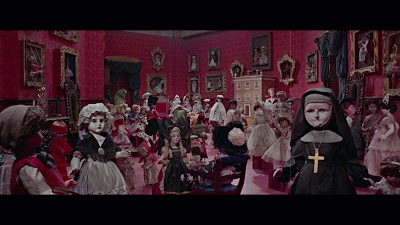 |
| Margaret Johnson in her doll palace. |
Since its original release in 1966, the Paramount release has been all but impossible to see - except in a pan-and-scanned copy that first ran on TNT with commercial interruption way back when I first taped it, eager to see one of the more important titles that eluded me back in the day. It more recently ran on TCM in the same ugly copy. But this past week it was released on Blu-ray by Kino Lorber in an actual Techniscope presentation. Imagine how these frames would have looked cut in half to fit your TV screen...
 |
| Patrick Wymark interrogates the principal cast. |
I am surprised to report that I have done A COMPLETE TURNAROUND! With the full frame revealed, with the contrast corrected, the film has a marvelous look, with a strong cast and an Elisabeth Lutyens score with a eerie lullaby motif. I believe there may also have been a scene or two cut from the version I had previously seen, as some girly photos are taped to a man’s wall, a bit stronger than Paramount would have allowed for an all ages matinee movie in 1966. Not to mention half the screen was missing in every shot of that TV print! Admittedly, the Robert Bloch script is a little obvious, but the actors are top notch and the team responsible for THE SKULL are turning the screws as ably as ever, with some masterful compositions and set pieces.
 |
| Judy Huxtable and Alexander Knox. |
This is now going to be my chief reference when I tell people that presentation has everything to do with how we respond to a film. Mind you, the opening reel of the film has some unavoidable scratches, but they are much easier to ignore when the frame brightens to a day scene - and thereafter it is smooth, enjoyable sailing. On Facebook, Kino Lorber's Frank Tarzi has credited disc producer Bret Wood with being wholly responsible for the reconstruction of the film's Techniscope elements and color correction, making it releasable in the first place as a more elaborate restoration would have been outside the company's budget. The color palette is essential to the film's enjoyment, featuring extraordinary uses of lavender and royal blue that I'd never noticed in my old faded copy. There's also an audio commentary by Troy Howarth and a grab bag of trailers for similar recent Kino Lorber product.
Very happy to scratch this important restoration off my list of disappointments after all these years... but don't get me started on THE DEADLY BEES (also 1966), pretty much an abject failure from the same filmmakers!
(c) 2018 by Tim Lucas. All rights reserved.




